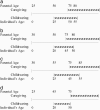Population distribution and redistribution of the baby-boom cohort in the United States: recent trends and implications
- PMID: 16230635
- PMCID: PMC1266126
- DOI: 10.1073/pnas.0507318102
Population distribution and redistribution of the baby-boom cohort in the United States: recent trends and implications
Abstract
Over 70 million people were born into the baby-boom cohort between 1946 and 1964. Over 65 million of these individuals are presently alive, and thus the cohort continues to exert a powerful influence on regional population change in the United States. In this article, we examine the recent and current geographic distribution of the baby-boom cohort. In 1990, the members of the cohort comprised a particularly high proportion of the population in a small number of dynamic metropolitan areas. We also highlight the recent migration trends exhibited by this cohort; these trends are potentially important early indicators of the retirement-related migration patterns that the cohort might follow. The spatial redistribution of the cohort has many implications, including potentially significant consequences for intergenerational relationships and caregiving. Also highlighted in the article are the temporal and geographical implications for intergenerational caregiving. There has been much attention given to the "sandwich" generation, with its members having dual caregiving responsibilities to both parents and children. A more appropriate designation may be the "stretched" generation, because caregiving seems to extend over a long period. In particular, many members of the baby-boom cohort are beginning to care for their aging parents just as they finish child rearing.
Figures






References
-
- Byerly, G. & Rubin, R. E. (1985) The Baby Boom: A Selective Annotated Bibliography (Heath, Lexington, MA).
-
- Russell, C. (1987) 100 Predictions for the Baby Boom, (Plenum, New York).
-
- Gillon, S. (2004) Boomer Nation: The Largest and Richest Generation Ever, and How it Changed America (Simon and Schuster, New York).
-
- Rogerson, P. (1999) in Migration Restructuring in the United States: A Geographic Perspective, eds. Pandit, K. & Withers, S. D. (Rowman and Littlefield, New York), pp. 174-192.
-
- Plane, D. A. & Heins, F. (2003) Ann. Reg. Sci. 37, 107-130.
MeSH terms
LinkOut - more resources
Full Text Sources

